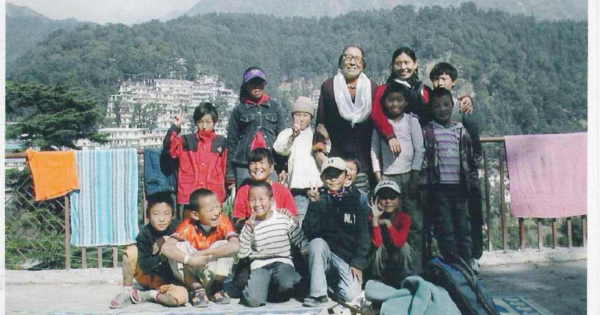Adhe Tapontsang, a former Tibetan political prisoner who played not only a supporting role but an integral part in the resistance to the Chinese invasion of Tibet, passed away in Dharamsala, India on Aug. 3, 2020. Her relatives informed Tibetan media that she peacefully passed away.
Popularly called “Ama” (mother) Adhe, she was born in 1932 (in a 2012 interview, she gave her age as 84, which would make her age as 92 at the time of her death) in Nyarong (Chinese: Xinlong) in eastern Tibet (in Sichuan province).

Ama Adhe with a group of Tibetan children participating in the Art Refuge program for newly arrived refugees in Dharamsala. ICT’s Rowell Fund for Tibet had provided grants to the program in the mid 2000s.
She recalled growing up in a religious environment and how the arrival of Chinese forces changed the situation in her hometown. She saw Chinese planes bombing Tibetan monasteries and homes and killing Tibetans. She recalled, “All the snow-covered mountaintops turned red with blood. Corpses lay scattered.”
She then began working for the Tibetan resistance, first joining a women’s group. She was detained and imprisoned in 1958, altogether lasting for 27 years. For the first year, she was imprisoned in Dhartsedo (Chinese: Kangding). Thereafter, she was moved to a prison she says is called Changshita in Chinese and Gothok Gyalgo in Tibetan (we have been unable to identify its exact location) for three years. She was then taken back to Dartsedo for another three years before being held in Minyak Rangakha (Chinese: Xinduqiao) in Sichuan until her release.
In the prison called Changshita, she was with 300 other prisoners, out of which only four, including herself, survived the three-year ordeal. The rest died due to starvation and ill treatment in prison. She then vowed that if she ever regained her freedom, she would dedicate her life to drawing attention to her dead colleagues and the Tibetan struggle.
She was released in 1987 and subsequently escaped to India. Since then, she had been residing in Dharamsala. She worked in the Tibetan Reception Center there and also traveled within India and abroad to draw attention to the plight of the Tibetan people.
In 1997, she wrote a book titled “Ama Adhe: The Voice that Remembers: The Heroic Story of a Woman’s Fight to Free Tibet” to tell the world about Tibet. In October 1997, she came to Washington, DC to participate in activities coinciding with the visit of then-Chinese President Jiang Zemin. She spoke before a rally in front of the White House along with International Campaign for Tibet Chairman Richard Gere.
In a Tibetan Oral History Project interview, she mentioned the following: “It gave me the first fulfillment after I could tell everything to His Holiness [the Dalai Lama], right? And then all our sufferings in prison are put in that book, The Voice that Remembers. When I die, that book will remain, right? That is [number] two. Then I traveled to foreign countries of the world. I confronted Chinese in Germany where the Chinese also spoke and they accepted that it was Mao Zedong and not [they] who were involved. Then I visited Denmark, Holland, France, the United States, Canada, England and Japan. I spoke about the agonies that [I] suffered to all these countries. Then I felt, even if I die, this book cannot die; I have already spoken about everything [to the world]; I have related everything to His Holiness and now if I die, I am fulfilled.”
Ama Adhe had a son and a daughter from her first marriage. However, her first husband was poisoned by the Chinese prior to her imprisonment in 1958. After her release, her daughter was alive, but her son had died.
She subsequently married Rinchen Samdup and was with him in Dharamsala until he predeceased her.

